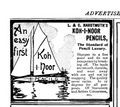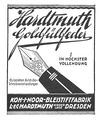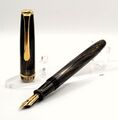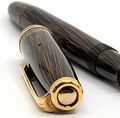Differenze tra le versioni di "Hardtmuth/en"
(Aggiornamento come da nuova versione della pagina di origine) |
|||
| Riga 1: | Riga 1: | ||
| − | <noinclude></noinclude>''Hardtmuth'' (or ''"L & C Hardtmuth"''), more commonly known as ''"[[Koh-i-Noor]] Hardtmudt"'', is a historic producer of pencils and office supplies that was founded in [[1790]] by ''Joseph Hardtmudt'', which in [[1802]] patented the first pencil made of clay and coal. Born in the Austro-Hungarian Empire, the company was transferred from the sons of the founder from Vienna to České Budějovice, currently in the Czech Republic. The company introduced in [[1889]] the line of pencils ''"Koh-i-Noor"'', called by the same name of the famous diamond to magnify their quality. To distinguish them, they were painted in yellow, a color that from then has become a classic for pencils. | + | <noinclude><div class="mw-translate-fuzzy"> |
| + | </noinclude>''Hardtmuth'' (or ''"L & C Hardtmuth"''), more commonly known as ''"[[Koh-i-Noor]] Hardtmudt"'', is a historic producer of pencils and office supplies that was founded in [[1790]] by ''Joseph Hardtmudt'', which in [[1802]] patented the first pencil made of clay and coal. Born in the Austro-Hungarian Empire, the company was transferred from the sons of the founder from Vienna to České Budějovice, currently in the Czech Republic. The company introduced in [[1889]] the line of pencils ''"Koh-i-Noor"'', called by the same name of the famous diamond to magnify their quality. To distinguish them, they were painted in yellow, a color that from then has become a classic for pencils. | ||
| + | </div> | ||
| + | <div class="mw-translate-fuzzy"> | ||
The ''Koh-i-Noor'' brand became the hallmark of the company, that with [[Faber Castell]] was one of the leading European pencils producers and is still on the market in the field of stationery and drawing tools. Not many details are known about the company's own productions of fountain pens, although there are some advertisements around the 1930s that show them under their own brand name, but very little is known about them. The company has marketed in several cases pens produced by others (in particular it marketed throughout Europe the [[Waterman]], for which it maintained representation until the First World War), but sometimes it has also marketed pens under its own brand. | The ''Koh-i-Noor'' brand became the hallmark of the company, that with [[Faber Castell]] was one of the leading European pencils producers and is still on the market in the field of stationery and drawing tools. Not many details are known about the company's own productions of fountain pens, although there are some advertisements around the 1930s that show them under their own brand name, but very little is known about them. The company has marketed in several cases pens produced by others (in particular it marketed throughout Europe the [[Waterman]], for which it maintained representation until the First World War), but sometimes it has also marketed pens under its own brand. | ||
| + | </div> | ||
| + | Le attività dell'azienda nel mercato delle stilografiche derivano principalmente dalla commercializzazione di penne prodotte da altri; in particolare commercializzava in tutta Europa le [[Waterman]], di cui ha mantenuto la rappresentanza fino alla prima guerra mondiale. Ma talvolta esiste anche una commercializzazione di penne con marchio proprio. Non sono noti molti dettagli sulle produzioni proprie di penne stilografiche, anche se ci sono alcune pubblicità intorno agli anni '30 che ne mostrano a proprio marchio ma di cui si sa pochissimo, ed ci sono evidenze di relazioni con la [[Union Vulpenhouderfabriek]] negli anni '50.<ref>come quella illustrata in [https://forum.fountainpen.it/viewtopic.php?t=32006 questa presentazione] sul forum.</ref> | ||
| + | |||
| + | <div class="mw-translate-fuzzy"> | ||
Refererences: | Refererences: | ||
[http://pencils.wikia.com/wiki/L%26C_Hardtmuth], [http://en.wikipedia.org/wiki/Koh-i-Noor_Hardtmuth], [http://it.wikipedia.org/wiki/Koh-I-Noor_Hardtmuth] | [http://pencils.wikia.com/wiki/L%26C_Hardtmuth], [http://en.wikipedia.org/wiki/Koh-i-Noor_Hardtmuth], [http://it.wikipedia.org/wiki/Koh-I-Noor_Hardtmuth] | ||
| + | </div> | ||
Available material: {{GenerateSmallBrandGallery|Hardtmuth}} | Available material: {{GenerateSmallBrandGallery|Hardtmuth}} | ||
Versione delle 19:43, 13 feb 2024
Hardtmuth (or "L & C Hardtmuth"), more commonly known as "Koh-i-Noor Hardtmudt", is a historic producer of pencils and office supplies that was founded in 1790 by Joseph Hardtmudt, which in 1802 patented the first pencil made of clay and coal. Born in the Austro-Hungarian Empire, the company was transferred from the sons of the founder from Vienna to České Budějovice, currently in the Czech Republic. The company introduced in 1889 the line of pencils "Koh-i-Noor", called by the same name of the famous diamond to magnify their quality. To distinguish them, they were painted in yellow, a color that from then has become a classic for pencils.
The Koh-i-Noor brand became the hallmark of the company, that with Faber Castell was one of the leading European pencils producers and is still on the market in the field of stationery and drawing tools. Not many details are known about the company's own productions of fountain pens, although there are some advertisements around the 1930s that show them under their own brand name, but very little is known about them. The company has marketed in several cases pens produced by others (in particular it marketed throughout Europe the Waterman, for which it maintained representation until the First World War), but sometimes it has also marketed pens under its own brand.
Le attività dell'azienda nel mercato delle stilografiche derivano principalmente dalla commercializzazione di penne prodotte da altri; in particolare commercializzava in tutta Europa le Waterman, di cui ha mantenuto la rappresentanza fino alla prima guerra mondiale. Ma talvolta esiste anche una commercializzazione di penne con marchio proprio. Non sono noti molti dettagli sulle produzioni proprie di penne stilografiche, anche se ci sono alcune pubblicità intorno agli anni '30 che ne mostrano a proprio marchio ma di cui si sa pochissimo, ed ci sono evidenze di relazioni con la Union Vulpenhouderfabriek negli anni '50.[1]
Available material:
- ↑ come quella illustrata in questa presentazione sul forum.



































